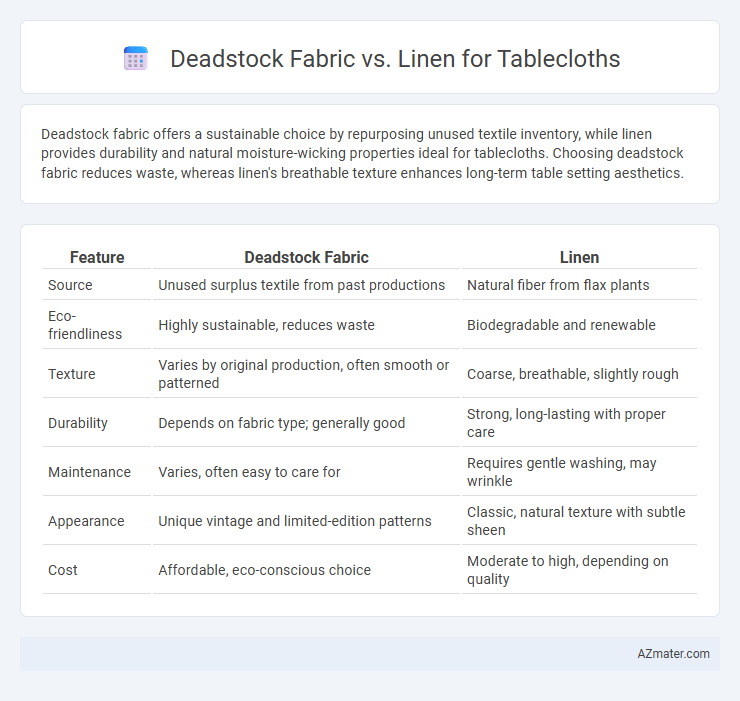Deadstock fabric offers a sustainable choice by repurposing unused textile inventory, while linen provides durability and natural moisture-wicking properties ideal for tablecloths. Choosing deadstock fabric reduces waste, whereas linen's breathable texture enhances long-term table setting aesthetics.
Table of Comparison
| Feature | Deadstock Fabric | Linen |
|---|---|---|
| Source | Unused surplus textile from past productions | Natural fiber from flax plants |
| Eco-friendliness | Highly sustainable, reduces waste | Biodegradable and renewable |
| Texture | Varies by original production, often smooth or patterned | Coarse, breathable, slightly rough |
| Durability | Depends on fabric type; generally good | Strong, long-lasting with proper care |
| Maintenance | Varies, often easy to care for | Requires gentle washing, may wrinkle |
| Appearance | Unique vintage and limited-edition patterns | Classic, natural texture with subtle sheen |
| Cost | Affordable, eco-conscious choice | Moderate to high, depending on quality |
Understanding Deadstock Fabric: An Overview
Deadstock fabric refers to unused, surplus textile material from previous manufacturing runs, often characterized by unique patterns and sustainable appeal due to reduced waste. Unlike linen, which is a natural fiber derived from flax and prized for its breathability and durability, deadstock fabric can vary widely in texture, weight, and fiber content. Choosing deadstock fabric for tablecloths offers an eco-friendly option that supports circular fashion, while linen remains preferred for its classic feel and natural moisture-wicking properties.
What is Linen? Key Characteristics
Linen is a natural fiber derived from the flax plant, known for its durability, breathability, and moisture-wicking properties, making it ideal for tablecloths that withstand frequent use. Its key characteristics include a slightly textured surface, exceptional strength, and resistance to dirt and stains, which improve with each wash. Linen's eco-friendly nature and timeless elegance contribute to its popularity in high-quality table linens compared to deadstock fabric options.
Sustainability Comparison: Deadstock Fabric vs Linen
Deadstock fabric, made from surplus textile materials, significantly reduces waste by repurposing unused stocks, making it a highly sustainable choice for tablecloths. Linen, derived from flax plants, offers natural biodegradability and requires less water and pesticides than cotton, enhancing its eco-friendly profile. Comparing sustainability, deadstock fabric minimizes resource consumption through reuse, while linen provides renewable and compostable qualities, both contributing to environmentally conscious tableware.
Aesthetic Appeal: Visual Differences in Table Settings
Deadstock fabric offers unique patterns and textures with a vintage charm, creating a one-of-a-kind aesthetic that enhances eclectic or rustic table settings. Linen, known for its natural fibers and elegant drape, provides a crisp, refined look with subtle texture and a matte finish that complements minimalist or classic decor. The visual contrast between deadstock fabric's rich designs and linen's understated simplicity allows tailored customization based on desired table setting ambience.
Durability and Longevity of Tablecloths
Deadstock fabric offers exceptional durability due to its tightly woven fibers and high-quality craftsmanship, making it resistant to wear and tear for long-term use. Linen, known for its natural strength and breathability, also provides impressive longevity, often softening yet maintaining integrity after multiple washes. Choosing between deadstock fabric and linen for tablecloths depends on the desired balance of durability, texture, and aging characteristics in everyday or formal settings.
Maintenance and Care: Which Is Easier?
Deadstock fabric often requires gentle care, such as cold water washing and air drying, to preserve its unique vintage qualities and prevent damage. Linen tablecloths are more durable and become softer with each wash, but they typically need ironing and may wrinkle easily after laundering. Overall, linen is easier to maintain for regular use, while deadstock fabric demands more careful handling to retain its original appearance.
Cost and Availability Analysis
Deadstock fabric offers a cost-effective option for tablecloths, often priced lower due to its surplus status, while linen typically commands a higher price because of its natural fibers and durability. Availability of deadstock fabric can be unpredictable and limited to specific designs or patterns, whereas linen is widely available in various weights and weaves from numerous suppliers. Choosing between deadstock fabric and linen depends on budget constraints and desired fabric consistency for tablecloth production.
Environmental Impact: Textile Waste and Resource Use
Deadstock fabric significantly reduces textile waste by repurposing excess or unsold materials from production, minimizing landfill contribution. Linen, derived from flax plants, is biodegradable and requires fewer pesticides and water compared to cotton, making it a sustainable choice in resource use. Combining deadstock fabric's waste reduction with linen's eco-friendly cultivation promotes a lower environmental footprint for tablecloth production.
Best Uses: Event Types and Venues
Deadstock fabric offers unique, vintage patterns ideal for rustic or themed events in boutique venues, adding a sustainable and eco-friendly touch to weddings or art exhibitions. Linen's natural texture and durability make it perfect for elegant formal dinners, outdoor garden parties, and upscale hotel banquets where easy maintenance and a refined look are essential. Choosing between deadstock fabric and linen depends on the event's style, venue ambiance, and guest expectations for comfort and aesthetics.
Making the Sustainable Choice for Tablecloths
Deadstock fabric offers a sustainable choice for tablecloths by repurposing unused textiles, reducing waste, and minimizing environmental impact compared to conventional linen production. Linen, derived from flax plants, is biodegradable and durable but often involves water-intensive cultivation and processing. Choosing deadstock fabric supports circular fashion principles by utilizing surplus materials, promoting eco-friendly practices without compromising style or quality.

Infographic: Deadstock Fabric vs Linen for Tablecloth
 azmater.com
azmater.com